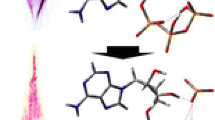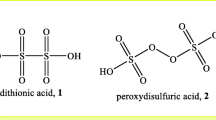Abstract
Electrospray ionization mass spectrometry (ESI-MS) technique was used to find out the type of species of uranyl with α-hydroxyisobutyric acid in positive and negative ion modes. It was found that the singly charged monomeric and doubly charged dimeric species were present in soft ionization conditions. The molecular level understanding on the structures and energetics were investigated using density functional theory based calculations. It was found that ML3, the most intense species observed in ESI-MS were energetically more favorable as compared to ML1 and ML2.









Similar content being viewed by others
References
Metz V, Geckeis H, González-Robles E, Loida A, Bube C, Kienzler B (2012) Radionuclide behaviour in the near-field of a geological repository for spent nuclear fuel. Radiochim Acta 100:699–713
Lochny M, Odoj R (1998) Separation of actinides by means of HPLC. J Radioanal Nucl Chem 228:165–169
Sachs S, Bernhard G (2011) Influence of humic acids on the actinide migration in the environment: suitable humic acid model substances and their application in studies with uranium—a review. J Radioanal Nucl Chem 290:17–29
Sundararajan M, Rajaraman G, Ghosh SK (2011) Speciation of uranyl ions in fulvic acid and humic acid: a DFT exploration. Phys Chem Chem Phys 13:18038–18046
Nash KL, Jensen MP (2001) Analytical-scale separations of the lanthanides: a review of techniques and fundamentals. Sep Sci Technol 36:1257–1282
Jaison PG, Raut NM, Aggarwal SK (2006) Direct determination of lanthanides in simulated irradiated thoria fuels using reversed-phase high-performance liquid chromatography. J Chromatogr A 1122:47–53
Datta A, Sivaraman N, Viswanathan KS, Ghosh S, Srinivasan TG, Vasudeva Rao PR (2013) Correlation of retention of lanthanide and actinide complexes with stability constants and their speciation. Radiochim Acta 101:81–92
Keith-Roach MJ (2010) A review of recent trends in electrospray ionisation–mass spectrometry for the analysis of metal–organic ligand complexes. Anal Chim Acta 678:140–148
Yu X, Xu X, Chen Z (2008) ESI-MS and theoretical study on the coordination structures and reaction modes of the diperoxovanadate complexes containing histidine-like ligands. Int J Mass Spectrom 269:138–144
Kumar P, Jaison PG, Sundararajan M, Telmore VM, Ghosh SK, Aggarwal SK (2013) Speciation of platinum-benzoylthiourea in the gas phase using electrospray ionization mass spectrometry and density functional theory. Rapid Commun Mass Spectrom 27:947–954
Jaison PG, Kumar P, Telmore VM, Aggarwal SK (2013) Electrospray ionization mass spectrometric studies on uranyl complex with a-hydroxyisobutyric acid in water–methanol medium. Rapid Commun Mass Spectrom 27:1105–1118
Moll H, Geipel G, Reich T, Bernhard G, Fanghanel T, Grenthe I (2003) Uranyl(VI) complexes with alpha-substituted carboxylic acids in aqueous solution. Radiochim Acta 91:11–20
Becke AD (1988) Density-functional exchange-energy approximation with correct asymptotic behavior. Phys Rev A 38:3098–3100
Perdew JP (1986) Density-functional approximation for the correlation energy of the inhomogeneous electron gas. Phys Rev B 33:8822–8824
Schäfer A, Huber C, Ahlrichs R (1994) Fully optimized contracted Gaussian basis sets of triple zeta valence quality for atoms Li to Kr. J Chem Phys 100:5829–5835
Weigend F, Ahlrichs R (2005) Balanced basis sets of split valence, triple zeta valence and quadruple zeta valence quality for H to Rn: design and assessment of accuracy. Phys Chem Chem Phys 7:3297–3305
Becke AD (1993) Density-functional thermochemistry. III. The role of exact exchange. J Chem Phys 98:5648–5652
Lee C, Yang W, Parr RG (1988) Development of the Colle-Salvetti correlation-energy formula into a functional of the electron density. Phys Rev B 37:785–789
Verma PK, Pathak PN, Kumari N, Sadhu B, Sundararajan M, Aswal VK, Mohapatra PK (2014) Effect of successive alkylation of N,N-dialkyl amides on the complexation behavior of uranium and thorium: solvent extraction, small angle neutron scattering, and computational studies. J Phys Chem B 118:14388–14396
Verma PK, Kumari N, Pathak PN, Sadhu B, Sundararajan M, Aswal VK, Mohapatra PK (2014) Investigations on preferential Pu(IV) extraction over U(VI) by N,N-dihexyloctanamide versus tri-n-butyl phosphate: evidence through small angle neutron scattering and DFT studies. J Phys Chem A 118:3996–4004
Ahlrichs R, Bar M, Baron H-P, Bauernschmitt R, Bocker S, Ehrig M, Eichkorn K, Elliot S, Furche F, Haase F, Haser M, Horn H, Huber C, Huniar U, Kattannek M, Kolmel C, Koolwitz M, May K, Ochsenfeld C, Ohm H, Schafer A, Schneider U, Treutler O, von Arnim M, Weigend F, Weis P, Weiss H TURBOMOLE V6.3.1 2011, a development of University of Karlsruhe and Forschungszentrum Karlsruhe GmbH, 1989–2007, TURBOMOLE GmbH, since 2007. http://www.turbomole.com
Van Stipdonk MJ, Chien W, Bulleigh K, Wu Q, Groenewold GS (2006) Gas-phase uranyl-nitrile complex ions. J Phys Chem A 110:959–970
Austin JP, Sundararajan M, Vincent MA, Hillier IH (2009) The geometric structures, vibrational frequencies and redox properties of the actinyl coordination complexes ([AnO2(L)n]m; An=U, Pu, Np; L=H2O, Cl−, CO3 2−, CH3CO2−, OH−) in aqueous solution, studied by density functional theory. Dalton Trans 30:5902–5909
Sundararajan M, Campbell AJ, Hillier IH (2008) Catalytic cycles for the reduction of [UO2]2+ by cytochrome c7 proteins proposed from DFT calculations. J Phys Chem 112(19):4451–4457
Acknowledgments
BS wants to thank Dr. Anil Kumar, Shri R. Singh and Dr. K. S. Pradeepkumar for their continuous support and encouragement. MS thanks Dr. B. N. Jagatap and the BARC computer centre for providing the high performance parallel computing facility (Adhya and Ajeya Systems). PK wants to thank Dr. S. Kannan, for his encouragement and guidance.
Author information
Authors and Affiliations
Corresponding authors
Electronic supplementary material
Below is the link to the electronic supplementary material.
Rights and permissions
About this article
Cite this article
Kumar, P., Jaison, P.G., Telmore, V.M. et al. Gas phase reactions of uranyl with α-hydroxyisobutyric acid using electrospray ionization mass spectrometry and density functional theory. J Radioanal Nucl Chem 308, 303–310 (2016). https://doi.org/10.1007/s10967-015-4664-6
Received:
Published:
Issue Date:
DOI: https://doi.org/10.1007/s10967-015-4664-6




